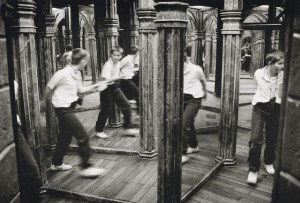Welcome To The Mirror
“Such lenses — when coupled with a next generation smartphone — will enable us to simultaneously exist in both the “Real” and the “Mirror,” with a plethora of “superpowers” at our disposal, all enabled by augmented reality apps as well as real time mapping to virtual space…”
Welcome to the Mirror.
You are probably going “huh” right about now, but relax, sit back, and play Jefferson Airplane’s “White Rabbit.”
Then read this article.
Way back when, over two years ago, in the second article I wrote for H+ magazine, I spoke about a video game called Fallen Earth that used real topographic maps, and discussed the fact that Google was in the process of creating a “Mirror World” of the entire Earth. At the time, they were close to finishing the complete “street view” project. Well that project is finished, and as predicted, Google didn’t stop…
And if you read the previous article of mine, you’ll also recall I mentioned mapping the insides of buildings? Yes, Google is doing that as well. Â In addition, browsing Google maps and Google Earth are becoming popular pastimes as people use the imagery to track down and share “geo-oddities”
I’ve also previously reported on Google’s plan for using quadrotors, the creation of low level aerial photos of all those areas which currently lack them, as well as the constantly growing number of 3d rendered buildings being added to the database daily by millions of Google users. Nor are they the sole player in this particular game, as C3 is offering ultra high quality 3d maps as well, based on declassified government reconnaissance technology, and even Microsoft is working on similar technology.
All of which brings us right back around again to the first link I provided up there. Sure, it’s a pretty lame game, more of a demonstration of the concept than a real First Person Shooter, but it’s the first of what is likely to be a completely new generation of games, and of game graphics engines, driven by real world data. Imagine merging the latest Call of Duty graphics engine with a Google mapped locale, enabling you to stage a “block war” with your friends, using your own neighborhood as a combat zone.
Sounds fun, hum? Now let me toss in another element to it — a Quadrotor. Imagine that not only are you using the Google maps recreation of your neighborhood for your shootout, but that you’re also using a quadrotor as your telepresence unit. Imagine that in addition to the static scenery like trees and houses, your game is real time, and the cars moving in the street and current activities around the neighborhood are also included and potential game changers. With a quadrotor as your POV cam, tracking your virtual avatar in the real neighborhood to provide that real time data for your “Mirrorworld” game, it’s more than possible — it’s likely to be a feature.
But such games are just the tiniest tip of the iceberg. I’ve talked previously about using such “Mirror” technology to enable you to visit an office halfway around the world to discuss business as if you were personally there. The needed sensor technology already exists, in the Kinect, to make it possible to animate a “real time” virtual avatar. We will inevitably create more advanced versions of the Kinect, and the adding of this technology to quadrotors has already happened in the lab.
When you also add in the latest developments in QLED displays, the probability of ultralight “VR” lenses should be readily apparent. That makes the use of “Avatars” even more likely, as we will need a “presence” in the “Mirror” outside of games. Such lenses — when coupled with a next generation smartphone — will enable us to simultaneously exist in both the “Real” and the “Mirror,” with a plethora of “superpowers” at our disposal, all enabled by augmented reality apps as well as real time mapping to virtual space, and inspired by a slew of video game “conveniences”, like “title bars” “tool tips” “minimaps”, and even “superhuman” vision, like telescopic, x-ray, microscopic, or low light vision. With a pair of lenses and a fully developed “Mirrorworld” such feats would be trivial.  The same goes for even more outlandish abilities such as “teleportation” that enables you to stay at home and visit anywhere in the world.
And if gaming, business, and all the rest leaves you cold, then imagine the educational potential of the “Mirror”. Not long ago, I spent a couple of hours touring Pompeii. I could do the same with NYC and Moscow, even Washington DC. In the not too distant future, I could likely do the same with the Guggenheim, or the Louvre. Imagine every museum and monument in the world — from the Forbidden Palace to the Sistine Chapel to the Taj Mahal — instantly accessible to any child in any school in any country. Imagine practicing your Japanese with a real Japanese tutor, or being given a tour of the Pyramids by an archeologist. With real time “Mirroring,” the entire world becomes an educational resource. Static photos will never convey the same impression of “being there” the way the “Mirror” will.
So yes, Welcome to the Mirror. Get comfortable. You are going to be living here soon.

